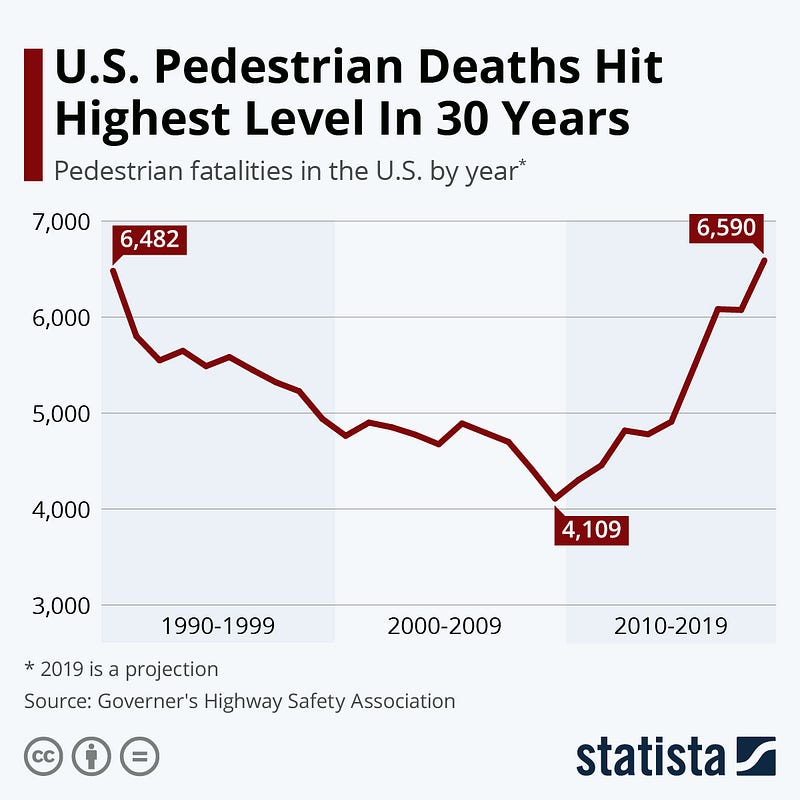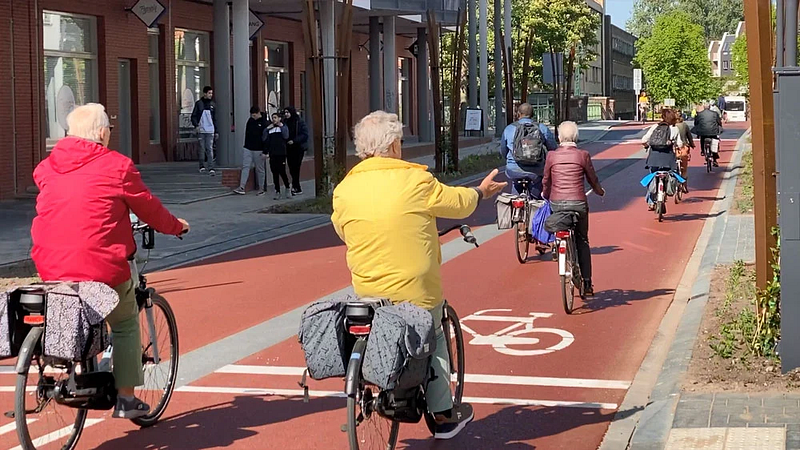When Sharing the Road Became Russian Roulette
The negative effects of car dependency and the significant improvements to Safety and Equality in places that invest in walkable infrastructure.
There are a multitude of problems with cars:
- They require too much space: endless freeways and parking lots for something that’s parked 99% of the time
- They’re expensive: cost of purchase/financing, gas, insurance, and maintenance
- They’re bad for the environment: single largest source of greenhouse gases (EV’s have a substantial carbon footprint too)
- They’re dangerous: causing 40,000 deaths annually in U.S.
Despite these points, car dependency has become widely normalized and so ingrained into our way of life that it’s hard to imagine a world without them.
Cars Cause Unnecessary Death
Cars are simply the most dangerous mode of transport today. It is ridiculous that we expect the vast majority of the population to operate a 2-ton machine capable of high speeds upwards of 80mph. And everyone has free reign to this privilege once they reach the age of 16.
Not surprisingly, traffic collisions are still a huge cause of death and even recently increasing in the U.S. This puts a huge strain on society. It’s likely you know several people who have been injured or killed in traffic collisions and dozens more by a degree of separation.

U.S. traffic safety is getting worst, while other countries improve
More alarming is that pedestrians killed by cars is now at a 30-year high:

Pedestrian deaths caused by vehicles is rising to it’s highest levels in 3 decades
Additionally, in neighborhoods across the country, thousands of children are injured or killed each year by drivers who don’t see them:

Child fatalities caused by large vehicles is at an all time high
Could it be due to zero regulation on the height and weight of SUV’s and trucks? Or the fact that car safety regulations only consider the safety of the driver and passenger—forgetting about pedestrians and cyclists?

Larger vehicles that impair visibility are the most popular vehicles sold
Should we just outlaw people from walking or biking for their own safety? /s

Far-right is an American truck parked in the Netherlands
How Do You Know When a City is Safe?
When women, children, and senior citizens are free to roam in peace without fear for their safety. Imagine a world where children and seniors had other options to get around town instead of being chauffeured.

However, when looking at North America, biking is often delegated to just two groups:
1. Young children who bike around their neighborhood after school
2. Sport cyclist for exercise (a.k.a. physically fit men in 20s and 30s)
Here, “Sharing the Road” is liken to playing Russian roulette.

A broad intersection that poses as a huge risk to pedestrians
This is primarily due to poor public infrastructure for pedestrians and biking in the vast majority of North American cities. No one bikes because it’s not safe to do so. Here, “Sharing the Road” is liken to playing Russian roulette.
So Safe That No Helmets Are Needed
This is all at a stark contrast to places like the Netherlands.
You may be surprised to know that bicycle helmets are rarely used because they simply aren’t needed.
The density and mixed zoning means you often don’t need to travel far nor quickly to reach your destination. And attention to pedestrian safety-first planning means that collisions between people, bikes, and cars are minimal. Without giant metal boxes obscuring visibility, body language is easier to read and speed to be judged and reacted to more quickly.
Thus, the lack of helmet hair in these places (An intersection in Utrecht, Netherlands):
North America has 24 hours to respond pic.twitter.com/0rj8H7Gto3
— Hayden Clarkin (@the_transit_guy) January 13, 2023
Not surprisingly, when a place is designed at a human scale (and not cars), all measures of safety are improved, as well as economic activity.
Public Infrastructure Increases Equality & Freedom
Thoughtfully designed and constructed public infrastructure, at large, is arguably the most equitable investment a society can make. Public infrastructure helps everyone in society from young to old. In a time where inequality is rising, we should invest in things that will bring up the quality of life for all in society.
The concept of personal mobility and convenient access through walking, biking, and public transportation aligns closely with the notion of freedom. The greater the range of choices available to us, coupled with minimal obstacles, the greater our freedom to pursue opportunities and leisure activities alike.
Thoughtfully designed and constructed public infrastructure, at large, is arguably the most equitable investment a society can make.

Osaka Station City — as the name suggest this train station has all the amenities of a city itself
Places like Utrecht, Netherlands and Osaka, Japan show great glimpses of a world with safe, accessible, car-free infrastructure. Their well designed urban areas make it so easy to travel with little barrier to access. We should look to these places as inspiration to model our own cities after.
Driving is a Gatekeeper to Opportunity
In the US, access to opportunities and a higher quality of life are often gate-kept by how much money you have. A simple thing such as mobility is gate-kept by car ownership due to cities being built prioritizing car travel.

The stroad — a dangerous high-speed, car-oriented, commercial development in North America
The fact that virtually everyone in the U.S. has to rely on driving to their daily destinations is baffling if you come from walkable cities in Europe or Asia, but is completely normalized if you’ve grown up living in North America.
There is a surprisingly large group of people that just can’t drive for one reason or another. To name a few: children, senior citizens, the physically disabled, and those who simply can’t afford to.
Picture living in a world designed for cars but you’re unable to drive. This lack of mobility would be a massive hindrance to your safety and your access to economic opportunities and everyday freedom. This world is a reality for many of those underprivileged, too young or too old, or living with disabilities. Cars not only senselessly endanger our lives, they also limit opportunity, but it doesn’t have to be this way…





